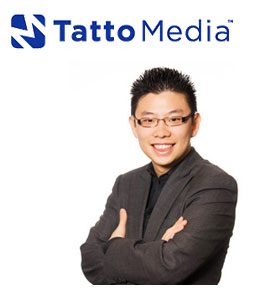Lin Miao is Chief Executive Officer of Tatto Media, an online advertising network.
AdExchanger.com: Tell us a little bit about Tatto Media. You position Tatto as an ad network, but during a recent panel at the ad:tech Chicago conference, you sounded more like a DR agency to me. What’s the story?
LM: Tatto Media is the third largest global advertising network (comScore, July 2009) and we are focused on performance campaigns. We tailor to advertisers that are familiar with direct response already and who are seeking a larger, more global audience in addition to requiring next generation behavioral tools that enables them to segment leads more accurately.
What momentum are you seeing on the client-side today?
We currently cater to more than 1,000 advertisers that fall specifically in the following categories: Finance, Education, Entertainment and Insurance. These clients are usually well-versed in direct response and are constantly looking for more accuracy and quality in the delivery of leads, larger scale and complete global presence.
Tatto Media was founded in 2005 and since then we believed that behavioral targeting should exist as a support tool specifically for direct response and not for brands. As more direct response agencies and networks enter the space, it is imperative that large advertising networks focus on technologies that can improve lead quality. Behavioral targeting makes sense in assisting advertisers to reach a higher quality of an audience and thus should increase conversions.
How is Tatto Media buying today from Publishers? Is it upfront, spot buying, etc.?
Tatto Media typically works with publishers on a revenue share.
Can you give us a sense of a typical campaign these days?
Tatto Media is a display advertising network. When looking at the overall network picture, there are very few display advertising networks that focus strictly on direct response clients. This is typically because the creative resources and customized tools required for lead generation is very different than the traditional CPM model.
A major difference in our self-serve display advertising platform is the fact that we focused much of the technology on the ability for advertisers to customize their banners on a performance level. As long as the creative is designed in flash, we can strip all elements of a creative such as color, wording, shades and elements and from there we can tell you if, say, blue is converting better than red. The advertiser is then given the opportunity to allow the system to change the creative automatically based on a proprietary algorithm. We understand that not all advertisers have a large graphics team that can modify every single banner so we created a tool that minimizes labor costs and increases the ease of getting a display campaign up and live.
How does Tatto Media differentiate itself from other ad networks? Is it all about effective arbitrage and/or is their proprietary technology involved?
Tatto Media strictly focuses on direct response clients. This enables us to be specialized in two specific areas: targeting (behavioral) and creative design (self serve creative optimization). Because of our global scale, it forces us to build sustainable technology that can automate much of this on a large scale. The sustainable technology that replicates our success on billions of monthly impressions is what differentiates us from the rest of the industry.
How do you see the ad network model playing out in the future?
While there are some doubts on the ad network model, ad networks will continue to exist on a consolidated level. For example, every network has its own strengths and weaknesses and there are various reasons why publishers choose one over another. Some networks may be experts at monetizing Japan, for example. A publisher cannot monetize every country effectively by themselves, nor do all have the resources to have a full blown sales team. Publishers will need help in certain countries or certain types of inventories.
And the agency model – what are your thoughts?
I do believe that more and more of the traditional advertising networks and agencies will need to build a performance/DR division as that is where much of the industry is moving toward even on a brand level.
Are ad exchanges good for ad networks? And, do you see impression-level, real-time bidding as a game-changer?
There are a lot of inefficiencies in the online advertising model between publishers, networks and advertisers. Ultimately, many publishers simply don’t know better and make less than they should. When a publisher chooses a network and runs a campaign, that campaign could be brokered 5-6 times, so naturally there exists 5-6 companies in the middle all taking their cuts. The result of this is that the publisher only makes maybe 25 percent of what it really should be making if it went directly to the advertisers. The trend between eliminating networks in the middle and a direct publisher to advertiser relationship is more imminent than ever.
Ad exchanges exist simply because of all of these inefficiencies. Ad exchanges even add an extra level of inefficiency into this mix. Once the inefficiencies get eliminated and the industry changes and improves, then the need for ad exchanges no longer exists.
Does brand advertising work on the Web?
We don’t work with brand campaigns, but I believe that brand campaigns need to evolve with more performance metrics embedded.
Finally, what’s the story with the spelling of “Tatto”? Inquiring minds want to know.
Tatto is Italian for “authentic”. We chose the name because of how Tatto was started – with only $100 between three college students. We find that to be quite a unique, and “authentic” start to a multi-million business.
Follow Tatto Media (@tattomedia) and AdExchanger.com (@adexchanger) on Twitter.












